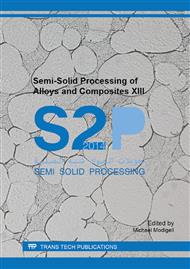[1]
T. G. N'guyen, D. Favier, and M. Suery, Theor. and experimental study of the isotherm. mechanical behaviour of alloys in the semi-solid state Int. J. Plast., 10, 1994, 663–693.
DOI: 10.1016/0749-6419(94)90028-0
Google Scholar
[2]
M. Modigell, J. Koke, and J. Petera, Proc. 5th Int. Conf. on Semi-solid processing of alloys and composites, Golden, Colorado School of Mines, 1998, p.317–326.
Google Scholar
[3]
J. -C. Gebelin: PhD thesis, INPG, Grenoble, France, (2000).
Google Scholar
[4]
M. Malik, G. Lambotte, M. S. Hamed, P. Chatrand, S. Shankar, How to measure viscosity of liquid aluminum alloys, TMS Orlando 2007, pp.43-50.
Google Scholar
[5]
M. Malik et al., Rotational rheometry of liquid metal sys.: Meas. geometry selection and flow curve analysis, J. of N. -Newt. Fluid Mech., 165, 13–14, 2010, p.733–742.
DOI: 10.1016/j.jnnfm.2010.03.009
Google Scholar
[6]
M. Jeyakumar, M. Hamed, S. Shankar, Rheology of liquid metals and alloys, Journal of Non-Newtonian Fluid Mechanics, 166, 2011, p.831–838.
DOI: 10.1016/j.jnnfm.2011.04.014
Google Scholar
[7]
V. Varsanl, Z. Fan, Non-Newt. behav. of liquid metals, TMS, Orlando 2007, pp.67-76.
Google Scholar
[8]
C. Desgranges, J. Delhommelle, Visc. of liquid iron under high press. and hightemp.: equilib. and non-equi. Mol. dyn. simulation, Phys. Rev. B 76, 2007, pp.172102-06.
Google Scholar
[9]
Y. Qi et al., Viscosities of liquid metal alloys from non-equilib. molecular dynamics, Journal of Computer-Aided Materials Design 8, 2001, pp.233-43.
Google Scholar
[10]
I. M. Krieger, T. J. Dougherty, A mechanism for flow in suspensions for rigid spheres, Transactions of the society of rheology III, 1959, pp.157-152.
DOI: 10.1122/1.548848
Google Scholar
[11]
S. Harboe, M. Modigell: Yield stress in semi-solid alloys - the dependency on time and deformation history, Key Engineering Materials, 554-557, 2013, pp.523-535.
DOI: 10.4028/www.scientific.net/kem.554-557.523
Google Scholar
[12]
M. Modigell, T. Volkmann, C. Zang, A high-precision rotational rheometer for temperatures up to 1700°C, Solid State Phenomena-Semi-Solid Processing of Alloys and Composites XII, 192-193(B), 2013, pp.359-364.
DOI: 10.4028/www.scientific.net/ssp.192-193.359
Google Scholar
[13]
M. Modigell, J. Koke, Flow behaviour of semi-solid metal alloys, Journal of non-Newtonian fluid mechanics, 112, 2003, pp.141-160.
DOI: 10.1016/s0377-0257(03)00080-6
Google Scholar
[14]
S. Harboe, M. Modigell, The Influence of Particle Size on Viscosity in Thixo Material. Key Engineering Materials, 504 - 506, 2012, pp.333-338.
DOI: 10.4028/www.scientific.net/kem.504-506.333
Google Scholar
[15]
M. Modigell, A. Pola, Modeling of shear induced coarsening effects in semi-solid alloys, Transactions of Nonferrous Metals Society of China, 20, 9, 2010, pp.1696-1701.
DOI: 10.1016/s1003-6326(09)60360-5
Google Scholar
[16]
M. Modigell, S. Harboe, Wall slip of semi-solid A356 in Couette rheometers, Esaform Conference 2011, Belfast, UK, (2011).
DOI: 10.1063/1.3589659
Google Scholar
[17]
P. Carreau. Rheol. equations from molec. netw. theories, J. Rheol., 16, 1972, p.99–127.
Google Scholar
[18]
A. R. A. Mclelland, PhD Thesis, University of Sheffield, (1993).
Google Scholar
[19]
M. Avedesian, H. Baker, Magnesium and Magnesium Alloys, ASM International, (1999).
Google Scholar
[20]
L. Li, X. Zhou, J. Chen, A Rheological Model of Semisolid Magnesium Alloy Slurries, Materials Science Forum Vols. 488-489, pp.333-336, (2005).
DOI: 10.4028/www.scientific.net/msf.488-489.333
Google Scholar
[21]
L.S. Turng, K.K. Wang, Rheological behaviour and modelling of semi-solid Sn-15%Pb alloy, J. Mat. Sc. 26, 1991, pp.2173-2183.
DOI: 10.1007/bf00549185
Google Scholar
[22]
M. Modigell, C. Zang, A. Pola, M. Suéry, Investigation of correlations between shear history and microstructure of semi-solid alloys, Solid State Phenomena Vols. 192-193 (2013) pp.251-256.
DOI: 10.4028/www.scientific.net/ssp.192-193.251
Google Scholar


